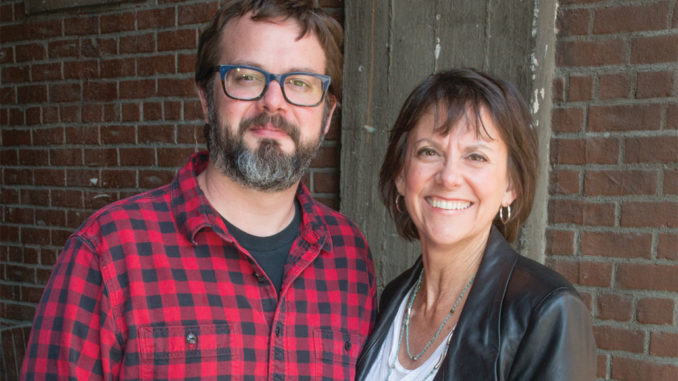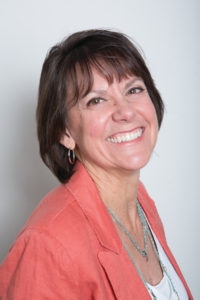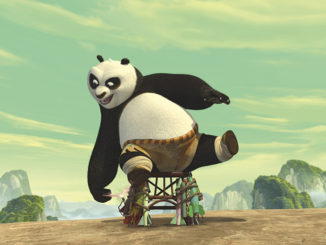
by Rob Feld • portraits by Deverill Weekes
With franchise films becoming increasingly commonplace as studios look to capitalize on past successes and brands, so are recurring creative teams, who stick together through the series. Such has been the case with Debra Neil-Fisher, A.C.E., and her collaborations with director Todd Phillips on The Hangover trilogy, as well as Jay Roach on the Austin Powers films. While Hangover Part II was co-edited with Mike Sale, Part III — which opens May 24 through Warner Bros. — sees the co-editorship of Jeff Groth, who brought to the mix a strong background in documentary, including Bill Maher’s comedic Religulous (2008).
Neil-Fisher attended USC Film School and zeroed in on editing while working as a staff assistant editor at a commercial production house. To move toward dramatic material, she started cutting whatever she could, eventually editing Ray’s Male Heterosexual Dance Hall (1987), which won an Oscar for Best Short Film. She continued editing commercials and trailers to pay the bills, and assisting editor-cum-director Jeff Kanew on projects like Revenge of the Nerds (1984) and Gotcha! (1985), before cutting V.I. Warshawski (1991) for him. It was not by design, but from there she has established herself as a premiere editor in the typically male world of American comedy.
Groth had a somewhat similar early trajectory, first encountering an Avid during a college advertising course. He started working at an Avid training center in Portland, Oregon until he moved to New York, then Los Angeles, where he cut shorts, promos and whatever he could find, also aiming to move toward dramatic material. After Religulous, however, he found a solid home for himself in television comedy, working on Community (2009-present) and Entourage (2004-11) before he was offered Project X (2012), produced by The Hangover’s Phillips. That key relationship united him with Neil-Fisher. “To be hired onto a film that you’re already a fan of — and get to not only watch, but be a part of the first cut of a movie you would go to see anyway — it doesn’t get much better than that,” he says.
CineMontage interviewed the two editors as they were finishing work on the film.
CineMontage: The apprenticeship experience can be formative; how was that early experience for you, Debra?
Debra Neil-Fisher: Jeff Kanew was a very good editor. He cut Ordinary People [1980], and Revenge of the Nerds was his first feature as a director. I sat with him on Nerds and a couple of his other films, and learned to edit features. He had started in trailers and advertising also, so we really connected on that level. I was lucky to meet a filmmaker who was an editor, and would allow me to sit with him and learn his craft. He was so good at using every aspect of editing: music, sound, dialogue, picture and the combinations thereof. Whatever format we work on, editing is really about the manipulation of those elements.
“Todd has a much more naturalistic, realistic approach, versus a manipulative one. In other styles of comedy, you edit towards a joke, rather than letting things play.” – Debra Neil-Fisher
CM: You’ve made such a place for yourself in comedy, which traditionally has been such a boys’ club. Has that ever been an issue?
DN-F: It hasn’t changed at all. Absolutely, it’s still a boys’ club; I just happened to be able to fit into it quite well. Since I was young, I’ve always been able to hang around the boys and not be intimidated. I don’t quite know why that is.
In terms of comedy, I sort of fell into it. The very first feature I cut was Fried Green Tomatoes [1991], which was a dramedy. I did Up Close and Personal[1996] with Jon Avnet, and we worked together for a number of years. When Jon didn’t have a film going, he introduced me to his partner Steve Tisch, who was producing a film call Dear God [1996]. The director was Garry Marshall. After working with Garry, I got jobs editing comedies, and many have been successful. If you do a number of films in a row in one genre, you get pigeonholed. I’ve enjoyed working on them, so that’s okay with me. And it’s fun to make people laugh. I’m lucky to be stuck in a genre that I enjoy.
CM: For women who want to edit comedy, is that what you think is necessary — to be able to hang with the boys?
DN-F: That’s hard to say for each person, but for myself it’s never really been an issue; I just ignore that aspect of the work. I moved right into that world and brought a lot to what’s going on in it. I think that bringing the female point of view has really added to the comedies I’ve worked on, and I don’t think it’s been ignored at all. Even recently on Ted [2012], I brought a lot of female perspective to a movie that had quite a male — even derogatory — view toward women. Appealing to both male and female audiences is what makes these comedies work. If you’re not going for both, you’re going to have a pretty narrow group that goes to see the film.

CM: How would the two of you describe the particular brand of comedy that is The Hangover series, and what are its demands?
eff Groth: It’s not really traditional broad comedy. There are occasional broad elements, but it’s metering out those broad elements, and have it work as…
DN-F: …grounded.
JG: Right, to keep it grounded and in a realistic place, where everything really could happen. Especially in The Hangover series, that seems particularly important.
DN-F: It makes it more relatable that way.
JG: Relatable in that it could be you or anybody that experiences these ridiculous situations. It makes the situation ridiculous and less so the characters — though there are some ridiculous characters in there.
CM: Jeff, you have a fairly heavy documentary background. Does the documentary experience inform how you’re now approaching comedy and your narrative features?
JG: I’ve always tried to cut my documentaries as though they were narrative features, and my narrative features like documentaries. They absolutely inform each other. Project X was basically a found-footage feature, so it did have some elements of documentary to it. It was more documentary-style cutting because, even though you had six takes from which to chose, due to the form you wouldn’t have reaction shots or inserts with which to work. We were putting cuts in the middle of takes the way you might in a documentary to tell the best story, but it also fit the style of the film.
With documentary, you try to bring out characters. It’s fundamental storytelling: You have to take this collection of footage that doesn’t have a script, but perhaps has an outline, and put together what you would see as characters, a plot and a first, second and third act. You’re creating that from what you’ve been given, and you want viewers to feel something. In that way, you do try and make a narrative feature out of it, even though it’s about something that’s actual.
As far as for narrative features, it’s making it as real as possible. Especially with something like The Hangover Part III, it’s about making the story feel like it could really happen, and cutting it in a style that doesn’t call attention to the hand of the filmmakers.

CM: Debra, is there a difference between doing a sequel, let alone a trilogy, as compared to coming in on a fresh project with no set expectations?
DN-F: Yes, but only because the characters are known and in some cases the story is similar, like the sequel to The Hangover. So there was a certain familiarity that we brought stylistically. But there’s also a shorthand that comes from knowing the director and what he’s looking for. It makes the process a little easier and a little bit quicker. With sequels, it just so happens that you have the same characters going through new situations. Other than that, you deal with each movie as its own film.
CM: Jeff, how is it to come into a series of films that already have existing teams and conventions?
JG: There are definitely some distinct pressures with coming onto a third installment. You want to be true to a franchise that is not only successful but loved, and has a high set of expectations attached to it. You’re also working within a set of boundaries that have already been created. I’m constantly evaluating the material by asking, “Is this something that feels like it would fit into Part I or II?” At the same time, since most of the characters are already established, you can get right to the story without so much screen time spent introducing them to the audience.
CM: Can you define Phillips’ craft? How he likes to work comedy in the editing?
DN-F: Todd has a much more naturalistic, realistic approach, versus a manipulative one. In other styles of comedy, you edit towards a joke, rather than letting things play. Understanding timing doesn’t change no matter what type of comedy, though — how a joke is going to play out, when a line happens, if one joke is getting a bigger laugh than another, which jokes you keep and which ones you don’t — those are the same in all comedies. But there are different styles of shooting; Todd’s approach is “Is this possible? Would this really happen? Are the characters bringing the comedy to the situation?”
CM: Does he let the viewer’s eye find the joke?
JG: I would say the viewer’s sensibility finds the joke.
CM: What did you find particularly challenging on this third Hangover?
DN-F: There are a lot more visual effects in this movie than people would imagine. We’ve got big sequences, lots of green screen and added effects. It’s a much bigger scale than the first two movies, but the same kind of schedule. So it’s tight.

Warner Bros. Pictures
CM: Has that impacted how you’ve worked with your assistants on this installment?
DN-F: Our assistants, Dave Clark and Scott Burnett, have worked on all of The Hangover films, as well as with me on Due Date [2010] for Todd. Dave has worked for me for 20 years, and we have worked on and off with Scott since 1998. We have an amazing shorthand, and both assistants are fantastic at their jobs.
On the first Hangover, there were 80 visual effects shots, which Dave and Scott easily handled themselves. On Hangover II, there were over 200 effects shots, for which they did almost all the temp mock-ups in the cutting room. On Hangover III, there are 556 visual such shots, so we added visual effects editor Jody Rogers to help handle the workload. This is unusual for the type of comedies we work on. The size of the production has grown in scale on all levels.
CM: What is it like working with another editor as a team?
JG: Many people would think that two editors on one show would constantly be stepping on each other, but that’s not the experience that we’ve had at all. We both bring our own individual experiences, opinions and points of view to the cutting room. So you have constant access to a new perspective or second opinion on everything you do.
DN-F: A fresh set of eyes is one of an editor’s most valuable tools. We find that working with another editor on a film is as important a collaboration as working with a director.






